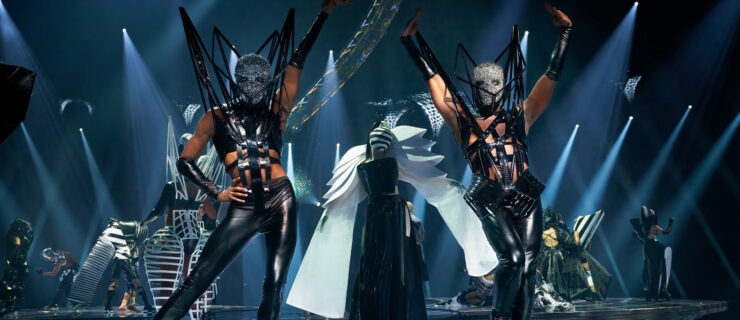4 Broadway Casting Directors Share Their Biggest Audition "Don'ts"
Figuring out how to avoid getting cut in a musical theater audition can feel like a mystery. “It’s not just about your technique, it’s about the whole package of the person,” says Justin Bohon, a casting director at Binder Casting, whose clients include The Lion King on Broadway. But how do you present yourself in the best way possible, and avoid making a faux pas that distracts from what’s most important—your dancing? Bohon and three other casting directors gave us the scoop on their biggest audition pet peeves.
DON’T: Get caught off guard or flustered.
“You never know what style of choreography they’re going to throw at you,” says Duncan Stewart, a casting director and partner at Stewart/Whitley agency in NYC, which has cast Broadway shows including Chicago, On the Town, and Pippin. For example, at Chicago auditions, “you think it’s going to be Fosse, but quite often we’ll start with a ballet combination,” Stewart says. He and his fellow director and partner of the agency, Benton Whitley, recommend packing “every shoe imaginable” in your dance bag so you’re ready for anything, and bringing extra clothing options in case you’re asked to make adjustments. Stewart says directors will often call dancers they like up to the table and say things like, “We’re going to bring you back for the next combination, but get rid of the jeans,” or “Your dance outfit cuts you in half—it’s white on the top and blue on the bottom. Do you have something that will let us see your lines better?”
DON’T: Forget to put the “music” in musical.
Even if you nail the dance portion of the audition, showing up unprepared for the singing portion is a turnoff. “There’s nothing worse than seeing a great dancer come in and knock everybody’s socks off, only to come in for singing and say, ‘Oh, I don’t have any music,’ ” says Stewart. Whitley adds, “Even if you aren’t a strong singer, you still have to be able to tap into that same level of confidence and joy you have as a dancer.” It’s worth meeting with a vocal coach, preparing a song that fits your voice, and showing up with your sheet music ready to go for an accompanist. Bohon also points out that, with the variety in musical theater these days, it’s a good idea to have a couple of songs in different styles under your belt. “It gets a little old to me when you’re auditioning for a pop show, but the only song in your book is ‘All I Need Is the Girl’ and you sing it no matter what,” he says.
 A rehearsal with RWS Entertainment Group’s cast for Holland America Line’s “Koningsdam” (photo by Raquel Barroso, courtesy RWS Entertainment Group)
A rehearsal with RWS Entertainment Group’s cast for Holland America Line’s “Koningsdam” (photo by Raquel Barroso, courtesy RWS Entertainment Group)
DON’T: Give an expressionless performance.
Flawless technique is only one piece of the puzzle, and, in the end, it’s not what really makes you stand out. “You can tell within two eight-counts what type of a dancer and what caliber of talent and technique someone has,” says Bohon. “After that, I want to see that they can tell me a story.” Franklyn Warfield, senior casting director at RWS Entertainment Group, which does casting for several major cruise lines, resorts, and theme parks, cites one of RWS’ dance combos: It begins with four walks downstage. “I’ve pretty much made my decision about whether I’m going to continue watching you after those four walks,” he says. “If you’re not imbuing those four counts with everything that you have, then I don’t know what you’re doing.” That being said, he also cautions against being so expressive that you neglect the timing or change the steps of the choreography. “We want you to be colorful, but you also have to observe the lines in the coloring book,” he says.
DON’T: Literally dress the part.
Don’t show up in full costume unless it’s explicitly asked of you. “It’s a sign of being green,” says Stewart. He remembers one woman who auditioned for Chicago in rhinestone-buckled shoes, just like the ones Velma wears in the show. “It was a little bit like ‘womp womp,’ ” he says. “It sort of worked against her. It looked a little bit too cute and calculated, and distracted from her performance.” Still, make sure you do “live in the world” of the show, as Whitley puts it. Research the style and genre, and let that inspire your outfit. Another turnoff? Dancers who look like they just rolled out of bed, or put no extra effort into their appearance. “An audition is not class,” says Warfield. Your outfit might seem trivial compared to more important things—like your actual dancing—but it’s one of the easiest things to cut people for when competition is tight. “Often, the talent level is so high that we subconsciously find ourselves taking visual cues as to why dancers are not right for our show,” Whitley says.
DON’T: Forget why you’re there.
As daunting as the experience can be, make sure you let your love of dance shine through—it’s what brought you to the audition in the first place. “Entertainment, bottom line, is supposed to be fun,” says Whitley. “The people who are able to do that in auditions are the ones who book the job.”
A version of this story appeared in the July/August 2018 issue of
Dance Spirit with the title “Broadway Casting Directors’ Pet Peeves.”



